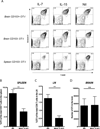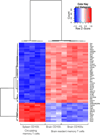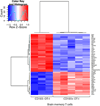The molecular signature of tissue resident memory CD8 T cells isolated from the brain
- PMID: 22922816
- PMCID: PMC3884813
- DOI: 10.4049/jimmunol.1201305
The molecular signature of tissue resident memory CD8 T cells isolated from the brain
Abstract
Tissue resident memory (Trm) CD8 T cells represent a newly described memory T cell population. We have previously characterized a population of Trm cells that persists within the brain after acute virus infection. Although capable of providing marked protection against a subsequent local challenge, brain Trm cells do not undergo recall expansion after dissociation from the tissue. Furthermore, these Trm cells do not depend on the same survival factors as the circulating memory T cell pool as assessed either in vivo or in vitro. To gain greater insight into this population of cells, we compared the gene expression profiles of Trm cells isolated from the brain with those of circulating memory T cells isolated from the spleen after an acute virus infection. Trm cells displayed altered expression of genes involved in chemotaxis, expressed a distinct set of transcription factors, and overexpressed several inhibitory receptors. Cumulatively, these data indicate that Trm cells are a distinct memory T cell population disconnected from the circulating memory T cell pool and display a unique molecular signature that likely results in optimal survival and function within their local environment.
Figures






References
-
- Masopust D, Vezys V, Marzo AL, Lefrancois L. Preferential localization of effector memory cells in nonlymphoid tissue. Science. 2001;291:2413–2417. - PubMed
-
- Sallusto F, Lenig D, Forster R, Lipp M, Lanzavecchia A. Two subsets of memory T lymphocytes with distinct homing potentials and effector functions. Nature. 1999;401:708–712. - PubMed
-
- Gebhardt T, Wakim LM, Eidsmo L, Reading PC, Heath WR, Carbone FR. Memory T cells in nonlymphoid tissue that provide enhanced local immunity during infection with herpes simplex virus. Nat Immunol. 2009;10:524–530. - PubMed
Publication types
MeSH terms
Substances
Associated data
- Actions
Grants and funding
LinkOut - more resources
Full Text Sources
Other Literature Sources
Molecular Biology Databases
Research Materials

